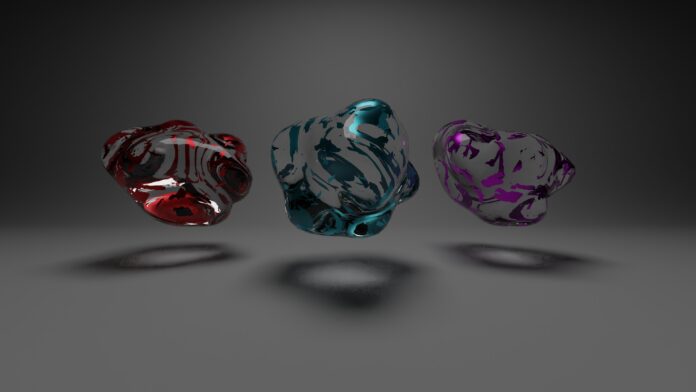Raytracing is a rendering technique that has revolutionized the way we create realistic computer-generated images. It simulates the behavior of light by tracing the path of individual rays as they interact with objects in a scene. This approach enables highly accurate rendering of shadows, reflections, refractions, and other complex lighting effects, resulting in stunningly realistic visuals.
In raytracing, a virtual camera shoots out rays from its viewpoint into the scene. These rays interact with the objects they encounter, and their behavior is determined by the physical properties of the materials and the lighting conditions in the scene. By tracing the path of each ray and calculating its interactions, the renderer can determine the final color and intensity of each pixel in the image.
One of the key advantages of raytracing is its ability to accurately simulate the way light interacts with objects in the real world. Traditional rendering techniques, such as rasterization, rely on approximations and shortcuts that can lead to less realistic results. Raytracing, on the other hand, provides a physically-based approach that can produce highly accurate and visually appealing images.
Now, let’s dive into ten important things you need to know about raytracing:
1. Realistic Lighting: Raytracing excels at simulating realistic lighting effects such as shadows, reflections, and refractions. It accurately calculates how light interacts with objects, resulting in visually stunning and lifelike scenes.
2. Global Illumination: Raytracing enables the simulation of global illumination, which takes into account the indirect lighting in a scene. It accurately models the way light bounces off surfaces, creating soft and realistic shadows.
3. Reflections and Refractions: With raytracing, it becomes possible to accurately simulate reflections and refractions. Mirrors and shiny surfaces reflect light rays, while transparent objects bend and refract them, resulting in accurate and realistic renderings.
4. Shadows: Raytracing provides accurate shadow rendering, including soft shadows and shadowing effects caused by multiple light sources. This adds depth and realism to scenes, making objects feel grounded in their environment.
5. Physically-Based Materials: Raytracing allows the use of physically-based material models, which simulate the interaction of light with different types of surfaces. This enables the creation of materials that accurately mimic real-world properties, such as metal, glass, plastic, and fabric.
6. Anti-aliasing: Raytracing inherently reduces the occurrence of jagged edges and aliasing artifacts, which are common in other rendering techniques. This leads to smoother, more refined images with improved visual quality.
7. Computational Intensity: Raytracing is computationally intensive, as it requires tracing the paths of individual rays through the scene. This makes it a resource-demanding process that often requires powerful hardware or dedicated graphics processing units (GPUs) for real-time applications.
8. Real-time Raytracing: Recent advancements in hardware, such as NVIDIA’s RTX series of GPUs, have made real-time raytracing possible. Real-time raytracing allows for interactive and dynamic scenes with highly realistic lighting effects, bringing cinematic-quality visuals to video games and other real-time applications.
9. Hybrid Rendering: Many modern rendering engines employ a hybrid approach that combines raytracing with traditional rasterization techniques. By using raytracing for specific lighting and reflection effects and rasterization for other elements, developers can strike a balance between visual quality and performance.
10. Future Applications: Raytracing has a promising future, not only in gaming but also in other fields like architecture, film production, and virtual reality. Its ability to generate realistic visuals will continue to push the boundaries of what’s possible in visual media.
Raytracing, with its ability to simulate realistic lighting, has become a game-changer in the field of computer graphics. By accurately tracing the paths of light rays as they interact with objects in a scene, raytracing enables the creation of visually stunning and lifelike images. It excels at rendering complex lighting effects such as shadows, reflections, and refractions, providing a level of realism that was previously unattainable with traditional rendering techniques.
One of the primary advantages of raytracing is its capability to simulate global illumination. Unlike rasterization, which approximates lighting effects, raytracing accurately models how light bounces off surfaces, resulting in soft and natural-looking shadows. This global illumination contributes to the overall realism of the scene, enhancing its depth and believability.
Reflections and refractions are other essential aspects of raytracing. Mirrors and glossy surfaces accurately reflect light rays, enabling the creation of highly detailed reflections. Similarly, transparent objects, like glass or water, refract light rays, accurately bending them according to their physical properties. The ability to simulate these effects with precision greatly enhances the realism of rendered scenes.
Shadows play a crucial role in creating depth and grounding objects within their environment. Raytracing excels at rendering shadows, including soft shadows and shadowing effects caused by multiple light sources. This capability adds another layer of realism to scenes, making objects feel more integrated and believable within their surroundings.
Moreover, raytracing allows for the use of physically-based material models. These models accurately simulate how light interacts with different types of surfaces, enabling the creation of materials that mimic real-world properties. Materials such as metal, glass, plastic, and fabric can be accurately represented, further enhancing the visual fidelity of rendered scenes.
In terms of image quality, raytracing inherently reduces the occurrence of jagged edges and aliasing artifacts, which can be common in other rendering techniques. This leads to smoother, more refined images, improving the overall visual experience for viewers.
It’s important to note that raytracing is computationally intensive. Tracing the paths of individual rays through a scene requires significant computational power. Real-time raytracing, especially for complex scenes, often requires dedicated hardware or powerful graphics processing units (GPUs) to achieve acceptable frame rates. However, advancements in hardware, such as NVIDIA’s RTX series of GPUs, have made real-time raytracing increasingly feasible, enabling interactive and dynamic scenes with highly realistic lighting effects, particularly in the gaming industry.
Many modern rendering engines employ a hybrid approach that combines raytracing with traditional rasterization techniques. This hybrid rendering approach allows developers to strike a balance between visual quality and performance. Raytracing can be used selectively for specific lighting and reflection effects, while rasterization handles other elements of the scene. This integration of raytracing and rasterization further expands the possibilities for achieving realistic visuals in real-time applications.
Looking ahead, raytracing has promising applications in various fields beyond gaming. In architecture, it enables architects to create realistic visualizations of their designs, helping clients and stakeholders better understand the final outcome. In film production, raytracing plays a vital role in generating high-quality visual effects and photorealistic animations. Virtual reality experiences can also benefit from raytracing, as it enhances the sense of immersion and realism, making virtual worlds feel more lifelike.
Raytracing is a powerful rendering technique that simulates the behavior of light, resulting in highly realistic computer-generated images. Its ability to accurately render lighting effects, reflections, refractions, shadows, and physically-based materials has revolutionized the field of computer graphics. With ongoing advancements in hardware and the increasing adoption of real-time raytracing, the future of this technique looks promising, pushing the boundaries of what can be achieved in terms of visual fidelity. Raytracing’s impact extends beyond gaming, finding applications in architecture, film production, and virtual reality, where its ability to create realistic visuals enhances various industries.
As technology continues to advance, the future of raytracing holds even more potential. Hardware optimizations, such as dedicated raytracing cores in GPUs, are expected to further improve performance and enable real-time raytracing in a wider range of applications. Software advancements will continue to refine the algorithms and techniques used in raytracing, allowing for more efficient and accurate simulations of light interactions.
In addition, the ongoing collaboration between hardware manufacturers, software developers, and content creators will drive the development of optimized workflows and tools for raytracing. This collaborative effort aims to streamline the process of creating raytraced content, making it more accessible to a broader range of artists and developers.
As raytracing becomes more prevalent, it will continue to push the boundaries of visual realism. Real-time raytracing in video games will offer unprecedented levels of immersion and visual fidelity, blurring the line between virtual and real worlds. Architectural visualizations will provide clients with incredibly lifelike representations of their projects, allowing for better decision-making and communication. Film and animation will see increasingly realistic special effects and highly detailed virtual environments. Virtual reality experiences will become more convincing, transporting users to intricately rendered and believable worlds.
In summary, raytracing is a groundbreaking rendering technique that has revolutionized computer graphics. Its ability to simulate realistic lighting, reflections, refractions, shadows, and materials has transformed the way we create and experience visual content. With ongoing advancements in hardware and software, the future of raytracing holds tremendous potential for pushing the boundaries of visual fidelity across various industries. Whether it’s in gaming, architecture, film production, or virtual reality, raytracing continues to pave the way for more realistic and immersive visual experiences.














